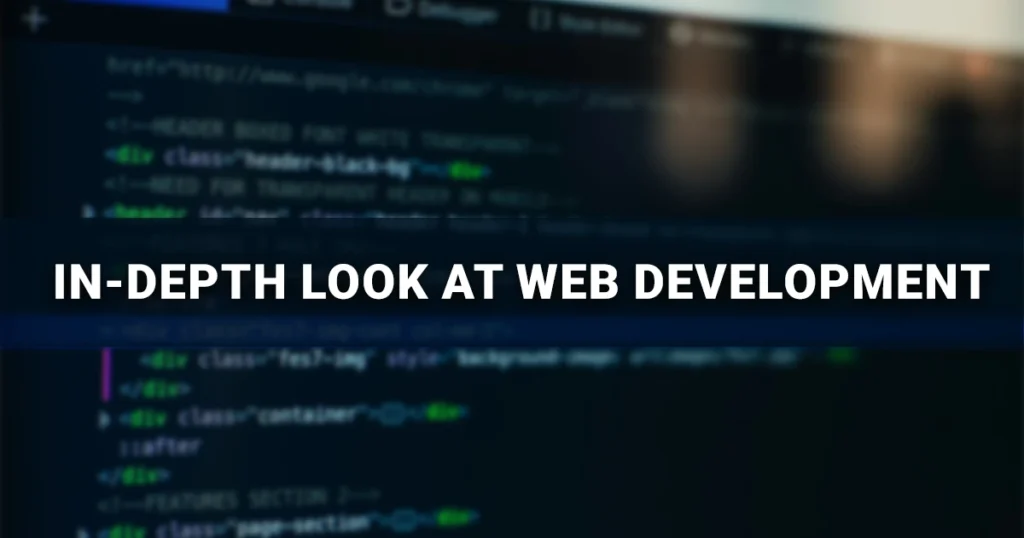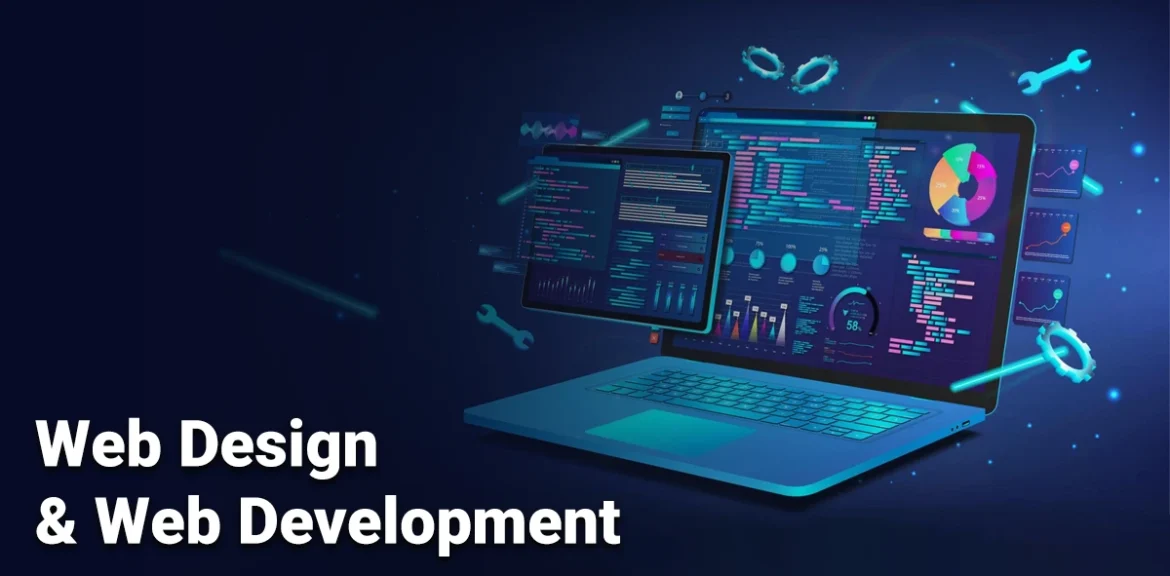The early 1990s saw the emergence of web design and web development & simple static text-based websites without interactive components. Today, however, websites are online portals bringing together people, businesses, and services in real-time. All said was not sheer chance.
The revolution was a gradual evolution of two specialized crafts-web design and web development. Using web design, the prior method of designing how information appears visually, its ways of creating user-friendly layout aesthetics, was replicated with web development as it progressed to fuel the engines for e-commerce, data-driven applications, and seamless interactivity.
Yet many still ask: “What’s the difference between web design and web development?” In this blog, we take you on a journey through this digital evolution to show how each discipline has carved its unique role and why both are indispensable today.
Defining Web Design and Web Development
Fundamentally, web design and web development entail two different, albeit closely interrelated, aspects of website creation.
- Web design refers to the artistic side of designing a site’s visual appearance and usability, and laying it out. Web design deals with the appearance of a site and how a visitor interacts with it.
- By contrast, web development is the technical realization of a site, including all the coding necessary to make sure that it works and is optimized across all devices.
The two functions merge in a complete digital product, but their focus areas remain distinct. Web design is concerned with beauty and user experience, whereas web development is concerned with functional implementation and performance.
See also: Web App vs Website: What’s the Real Difference
Detailed Overview of Web Design
What Is Web Designing?
Web design is the whole art and science of actually planning and building the front part of a website, and the specialization whose field focuses on how a website looks and feels is web design. Such sites are visually appealing and aligned with the brand in the same line while ensuring a smooth experience for users.
Key Elements of Web Design:
- User Interface (UI) Design
This is establishing visually enticing, consistent interfaces that navigate users throughout the site per the interface’s own internal logic.
- User Experience (UX) Design
Improvements in usability, access, and overall satisfaction for visitors to websites.
- Graphic Design and Branding
Integrating the company’s logos, icons, imagery, and consistent colour schemes as all part of the brand identity.
- Wireframing and Prototyping
Whereas wireframes systematically entangle the basic structure in general within web pages, prototypes allow interactivity, block-modelling scenarios for purposes of previewing how the final design should behave.
- Responsive Design
The site needs to be well-adapted to operate smoothly on a range of devices, from desktops to tablets and even mobile phones.
Tools Used in Web Design:
- Adobe Photoshop
- Adobe XD
- Figma
- Sketch
- InVision
Key Skills for a Web Designer:
- Graphic design proficiency
- Site design, typography, and colour theory knowledge
- Design principles and web-accessibility standards knowledge
- UX research and usability testing
Breath: At the end of it all, web design is a visual, creative process in which people carry out the creation of an intuitive, beautiful interface that will capture and inform users to act or convert them users.
See also: Website Design Cost in India: A Comprehensive Guide
In-Depth Look at Web Development

What is Web Development?
Web development constitutes an amalgamation of design makeovers into the configuration of an actual website’s workability. The possible work should be developing dynamic, interactive, and database-driven web applications for multi-platforms.
Generally, web development is broadly divided into two major fields:
a) Front-End Development (Client-side)
This involves the actual encoding or marking up of designs to create interactive and responsive environments. This part is where the user sees and interacts with it.
Technologies Used:
- HTML5: Structure of web content
- CSS3: Styles and layout
- JavaScript: User interactivity and dynamic content
- Popular frameworks:
- React.js
- Angular
- Vue.js
b) Back-End development (Server-Side)
Back-end development includes storage of data, application logic and server set-up. Thus, an action of the user would result in retrieving and performing respective actions in the application.
Technologies Used:
- PHP
- Python (Django, Flask)
- Node.js
- Ruby on Rails
- Database systems:
- MySQL
- PostgreSQL
- MongoDB
Some Essential Duties of a Web Developer:
- Code, pure, efficient, and difficult for maintenance.
- Connect the front-end design with the back-end systems.
- Create a database and control data flow through it.
- Implement protection rules like user authentication.
- Function testing and debugging.
To summarize, the website can also be capable of being interactive/spontaneous, agile in response to user inputs within the environment performing similarly to any other web-based development.
Side-by-Side Comparison: Web Design vs Web Development
| Aspect | Web Design | Web Development |
| Focus | Visual appearance and layout | Website functionality and performance |
| Primary Tools | Figma, Adobe XD, Sketch | VS Code, Git, Node.js |
| Main Skill Set | Graphic design, UI/UX, creativity | Programming languages, databases |
| Output | Static mockups and prototypes | Fully functional websites with dynamic features |
| User Interaction | User interface design | Backend processes like data handling |
| Key Concern | Aesthetics and usability | Security, speed, and responsiveness |
See also: Top Web Development Companies in Noida, Delhi
Web Design or Web Development: Which Is More Important?
Business proprietors often ask: Should I explore web designing or web development?
Well, the answer greatly depends upon individual factors:
In case your concern is to develop your professional digital brand presence, capture leads, or enhance customer relationship management, web design comes into play as that is responsible for the aesthetics and ease of navigation within your interface.
If you want your website to perform complex tasks such as operating e-commerce stores and online booking systems, or allowing user authentication and content management features, it turns out that development is a “must-do”.
In view of all such things, integrated design-development options provided by a full-service web design & development agency would likely suit most companies wishing to establish any kind of serious digital presence. This would ensure a good level of teamwork and would avoid communication problems that are usually encountered during the transition from designers to developers.
Why Web Design & Development Integration Is Essential?
Success is defined not just by creative designing, nor just by functional coding; rather, it takes both to achieve any end. It is a well-designed website that captures all the flaws when it goes wrong, whereas a good coding person can ignore all the sense with the application of bad art.
Advantages of Integration:
- Speedy project completion: It enables concurrent designing and development work, which greatly brings down the total time to completion of the project.
- Uniform user experience: Whatever a website looks like on a device, it must function the same.
- Focus on Performance and Scalability: Architects will be working against the design directions to make performance and scalable code.
- Maintenance is easy: The more seamless the integration of design and development, the smoother and less error-prone any updates would be in the future.
The successful candidates for the complete Web design and Web development service firms would thereby be able to enjoy systematic project processes, professional advice, and support from the conceptualization stage to the launch of a website.
See also: Why Choose Custom Web Development for Your Business
Emerging Trends: Web Design and Web Development
In this ever-evolving digital interface, here are some anticipated web development and design trends:
- Mobile-First Design: To cater to the most significant share of web traffic, mobile screens are designed first.
- Progressive Web Applications (PWAs): These are what enable users to use an application through a browser, with very fast loading times and offline usage.
- Single Page Applications (SPAs): Website apps are structured on a single HTML page, loading and changing their content dynamically without reloading.
- Headless CMS: Decouples content management from content presentation, offering developers freedom in application planning.
- AI-Powered Design Tools: These tools apply more machine learning in a bid to help automate design decision-making to speed up prototyping and coding.
These trends do reflect the increasing need for the collaborative work of web designers and developers in the architecture of websites for the future.
Conclusion: Web Design and Web Development
Very important to all individuals who are either starting or upgrading their online presence is having an understanding of the difference between web design and web development. At that, web design itself captures aesthetics and layout or interface aspects with a professional appearance, as well as an uninterrupted seamless experience for the users. The rest is left to the technical and coded logic, databases, and server environments within web development.
For their up-most benefit, businesses should acquire bundled web design and development services. This creates a site that functions, looks, and feels the same whether it is used internally or externally – one that attracts, keeps, and converts visitors into customers.
In short, a balanced digital approach would then have web designers and web developers working hand in hand seamlessly to achieve a digital solution that is as aesthetically pleasing as it is technically sound, bearing in mind the business objectives.
FAQ’s
Q1 What are web design and web development?
Web design focuses on the aesthetics, layout, and user experience of a website. Web development handles the technical side, coding, and functionality to ensure the site works properly across devices and platforms.
Q2 Is web development an extension of web design?
Web design and development are closely related but distinct. Design covers visuals and user experience, while development focuses on coding and functionality. Together, they form the complete process of website creation.
Q3 What do web designers do?
Web designers create the visual aspects of a website such as layout, color schemes, typography, and graphics. They also design wireframes and ensure the site is intuitive and appealing across devices.
Q4 What is a web developer all about?
Web developers convert designs into functional websites through coding. Front-end developers focus on the user-facing interface, while back-end developers handle databases, servers, and application logic.
Q5 Which holds more importance: web design or web development?
Both are equally important. Good design ensures user engagement and visual appeal, while development ensures usability, scalability, and security. A successful website requires a balance of both.





